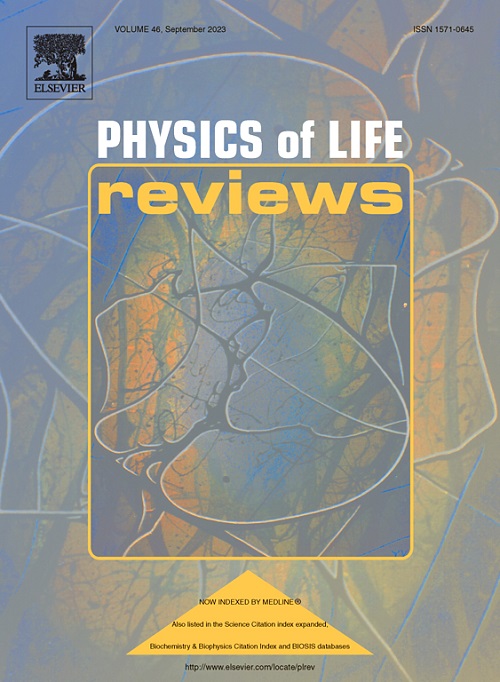生物学和生命科学中的非局部模型:来源、发展和应用
IF 13.7
1区 生物学
Q1 BIOLOGY
引用次数: 0
摘要
数学建模是理解发育生物学中生物物理机制的基本技术之一。它帮助研究人员分析复杂的生理过程,并在理论和实验观察之间架起一座桥梁。人们研究了各种各样的数学模型来分析这些过程,非局部模型就是其中之一。在物理和生物系统的现实数学模型中,当局部模型无法捕捉到发生在一定距离范围内的基本动力学和相互作用(例如,细胞-细胞、细胞-组织粘附、神经网络、疾病传播、特异性竞争、纳米束等)时,非定域性是重要的。本文综述了不同的非局部数学模型在生物学和生命科学中的应用。主要的焦点是这些模型的来源、开发和应用。除其他事项外,对种群动态生物系统中模式形成的条件进行了系统的讨论。特别关注网络上的非局部相互作用,网络耦合和整合,包括脑动力学模型,为更好地理解神经退行性疾病提供了重要工具。此外,我们还讨论了癌症干细胞和肿瘤细胞的非局部建模方法,这些方法广泛应用于任何器官的细胞迁移过程、生长和无血管肿瘤。此外,所讨论的非局部连续体模型可以用于足够小的尺度,包括纳米技术,在纳米技术中,经典的局部模型通常无法捕捉纳米尺度相互作用的复杂性,用于构建生物传感器来感知生物材料及其浓度。压电和其他智能材料就是其中之一,这些设备在与生物系统内在联系的数字和物理世界中变得越来越重要。此外,我们还回顾了非局部周动力学理论,该理论处理连续和离散介质,并适用于模拟皮质骨骨折和愈合之间的关系,组织生长和收缩,以及其他在生物医学和生物工程应用中日益重要的领域。最后,我们对新兴趋势进行了全面总结,并强调了这一快速发展领域的未来方向。本文章由计算机程序翻译,如有差异,请以英文原文为准。
Nonlocal models in biology and life sciences: Sources, developments, and applications
Mathematical modeling is one of the fundamental techniques for understanding biophysical mechanisms in developmental biology. It helps researchers to analyze complex physiological processes and connect like a bridge between theoretical and experimental observations. Various groups of mathematical models have been studied to analyze these processes, and the nonlocal models are one of them. Nonlocality is important in realistic mathematical models of physical and biological systems when local models fail to capture the essential dynamics and interactions that occur over a range of distances (e.g., cell-cell, cell–tissue adhesions, neural networks, the spread of diseases, intra-specific competition, nanobeams, etc.). This review illustrates different nonlocal mathematical models applied to biology and life sciences. The major focus has been given to sources, developments, and applications of such models. Among other things, a systematic discussion has been provided for the conditions of pattern formations in biological systems of population dynamics. Special attention has also been given to nonlocal interactions on networks, network coupling and integration, including brain dynamics models that provide an important tool to understand neurodegenerative diseases better. In addition, we have discussed nonlocal modeling approaches for cancer stem cells and tumor cells that are widely applied in the cell migration processes, growth, and avascular tumors in any organ. Furthermore, the discussed nonlocal continuum models can go sufficiently smaller scales, including nanotechnology, where classical local models often fail to capture the complexities of nanoscale interactions, applied to build biosensors to sense biomaterial and its concentration. Piezoelectric and other smart materials are among them, and these devices are becoming increasingly important in the digital and physical world that is intrinsically interconnected with biological systems. Additionally, we have reviewed a nonlocal theory of peridynamics, which deals with continuous and discrete media and applies to model the relationship between fracture and healing in cortical bone, tissue growth and shrinkage, and other areas increasingly important in biomedical and bioengineering applications. Finally, we provided a comprehensive summary of emerging trends and highlighted future directions in this rapidly expanding field.
求助全文
通过发布文献求助,成功后即可免费获取论文全文。
去求助
来源期刊

Physics of Life Reviews
生物-生物物理
CiteScore
20.30
自引率
14.50%
发文量
52
审稿时长
8 days
期刊介绍:
Physics of Life Reviews, published quarterly, is an international journal dedicated to review articles on the physics of living systems, complex phenomena in biological systems, and related fields including artificial life, robotics, mathematical bio-semiotics, and artificial intelligent systems. Serving as a unifying force across disciplines, the journal explores living systems comprehensively—from molecules to populations, genetics to mind, and artificial systems modeling these phenomena. Inviting reviews from actively engaged researchers, the journal seeks broad, critical, and accessible contributions that address recent progress and sometimes controversial accounts in the field.
 求助内容:
求助内容: 应助结果提醒方式:
应助结果提醒方式:


